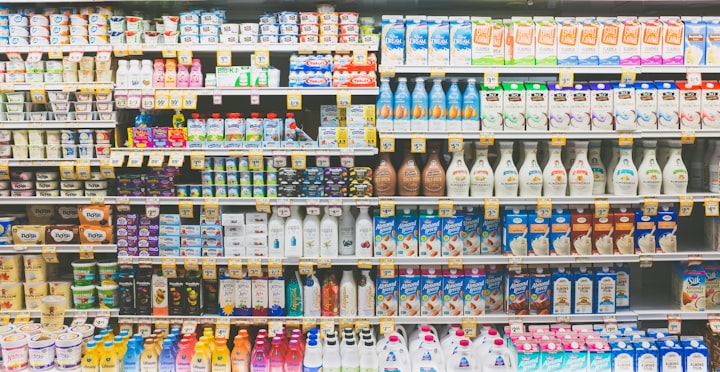What You Need to Know About Sugar
And how to avoid it.
The two white poisons. Salt and sugar. — a popular saying in Arabic
For years and years, we’ve been warned about the potential dangers of sugar. The truth is, in small amounts, sugar doesn’t pose much of a threat to a healthy individual. The worry comes with overconsumption.
Sugar is one of the most popular ingredients added to food in America. So we will be focusing on added sugar. Before digging into how you could decrease its consumption, it is crucial to be informed as to why you should limit sugar consumption in the first place.
What even is sugar?
In a nutshell, sucrose is found naturally in plants, from which table sugar is refined. Sucrose, the chemical name for sugar, is a simple carbohydrate that is found naturally in fruits, vegetables, and nuts. Sugar canes and beets possess the highest quantities of sugar. That is why they are the main choice for extraction.
Naturally occurring sugars Vs added sugars:
Naturally occurring sugars are, as their name implies, found naturally. An example would be fructose, the sugar found in fruits.
Added sugars are the sweeteners or sugars added to food or beverages during preparation or processing. Added sugars include white sugar, brown sugar, and honey. Other caloric chemically manufactured sweeteners are also added sugars (such as high fructose corn syrup).
How much added sugar consumption is acceptable?
The American Heart Association recommends women consume a maximum of 100 calories (about 6 teaspoons of sugar) and men 150 calories (about 9 teaspoons) per day.
How much we consume in reality:
For the average American, the consumption is 272 calories (17 teaspoons) a day. Please compare the recommendations with the actual consumption.

Why are we addicted?
Sugar addiction is not a delusion. Sugar stimulates the brain’s reward processing center in a similar way as the use of some recreational drugs.
The link between consuming added sugar and addictive behavior is that opioids and dopamine are released in the body when sugar is eaten.
The more you eat sweets, the more the brain will signal sugar cravings. Like with drugs, tolerance is built, so more sugar will be needed to meet your cravings.
Consequences of too much added sugar:
The consumption of an excessive amount of sugar can put a person at an increased risk for diseases like cardiovascular disease, diabetes, obesity, high blood pressure, cholesterol and triglyceride levels, etc.
Besides the diseases that sugar is linked to, other consequences of high sugar intake include cavities or tooth decay, inflammation, overeating, weight gain, skin aging, etc.
Where is it found?
The foods containing added sugar are overwhelming. Some of the top sources in our diet are soft drinks, cakes, candies, ice creams, flavored yogurt, and a great majority of processed foods.
The leading category source of added sugars is in beverages. These beverages include soft drinks, fruit drinks, sport/energy drinks, and coffee/tea.
It doesn’t even come close to ending there. Added sugar is hidden in many foods you wouldn’t think of like bread, ketchup, baby food, dried fruits, frozen foods, and the list goes on.

Now that we know the basics of sugar and its consumption, the question is, how can we decrease our intake?
1. Educate yourself
Education is key. And you’ve already started your journey by reading this article. But it’s not enough. The Internet is full of information to learn about what is healthy and what isn’t.
But don't believe everything you see. False information is everywhere on the Internet so save yourself the time and effort and know where to look such as trusted sites.
2. Monitor your intake
This healthy food journey is for you and it must adjust YOUR eating habits. Not anyone else's. So, in order to adjust, you must first know what needs to be changed. And this is where monitoring your food intake comes in.
Here is how you could monitor your intake:
You can write down everything you consume and see how much sugar is in each food component. At the end of the day, evaluate how much added sugar you had consumed.
Or, if you find this is too time-consuming, you could download a food tracker app where you log in what you ate and how much of it and it will directly tell you the nutrition composition.
3. Check the label
You’d be surprised what checking the label of a food product could unfold. That is of course if you know what to look for. Just because you don't see sugar in the ingredients list does not mean there is no sugar. It could be disguised under many names.
These are a few of the names: dextrose, fructose, galactose, glucose, dextrin, High-Fructose Corn Syrup (HFCS), molasses, brown sugar, and many others.
Watch out and don’t let the labels fool you.
4. Don't Buy it
So simple yet so hard right? Not really. If you have the proper education and motivation to look after your sugar consumption, you could do so successfully. You could find substitutes for food items with a high amount of added sugar.
But as we mentioned before, sugar seems to be everywhere. And this is where I take you back to point 1, educate yourself, know what you're trying to avoid, and avoid it. Don’t buy it. Know how to shop.
Yes, it might take time to get the hang of it, but it sure is worth it.

Your health is more important than the soft drink in your hand.
Let your journey start now. If you have made it this far, take on this challenge: Monitor your sugar intake and try to meet or fall below the added sugar recommendations for a week. Your health journey has started. Let’s get healthy.
About the Creator
Tina S
A poet, writer, and health enthusiast. I like to take a scientific look at normal life experiences.








Comments
There are no comments for this story
Be the first to respond and start the conversation.